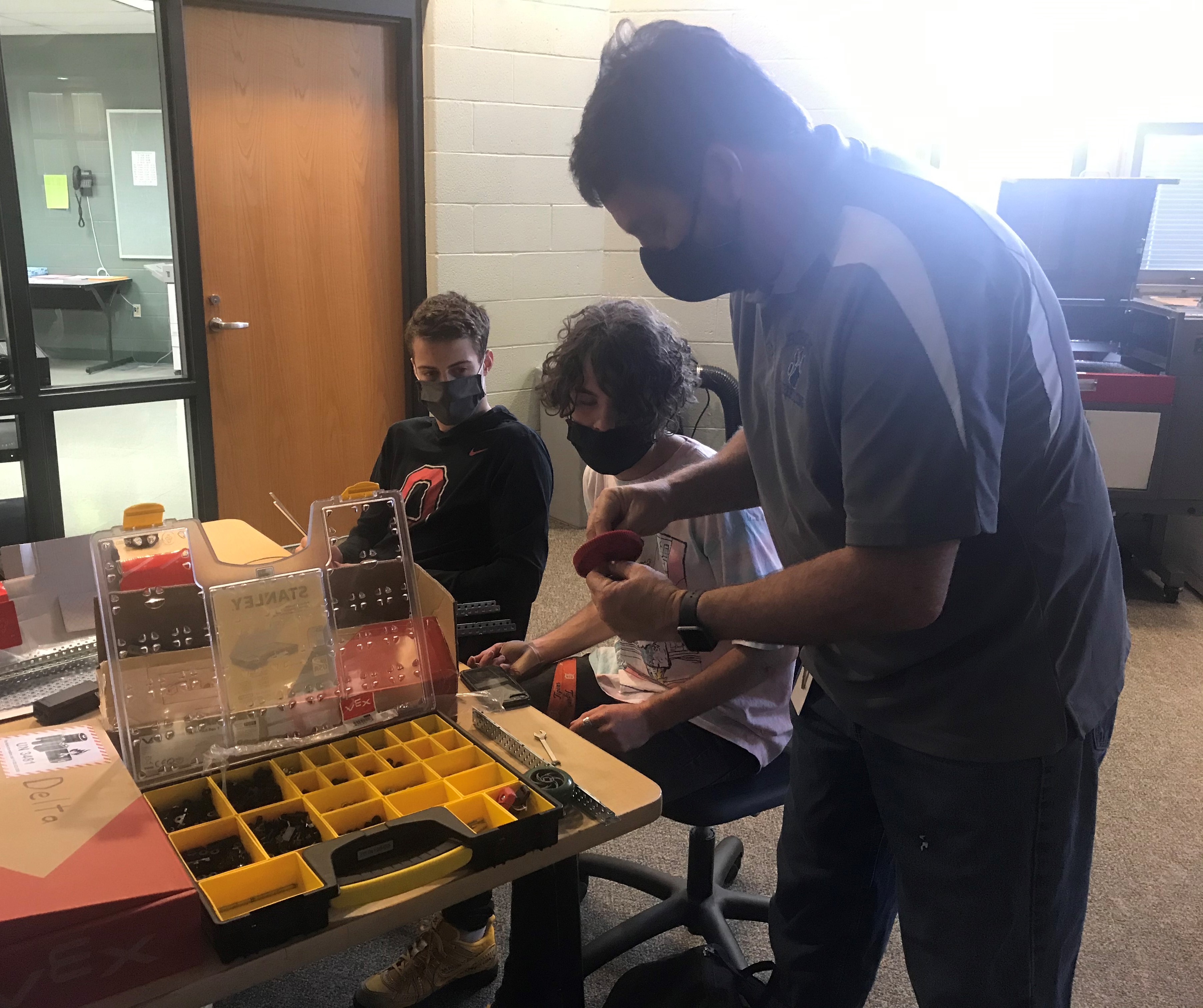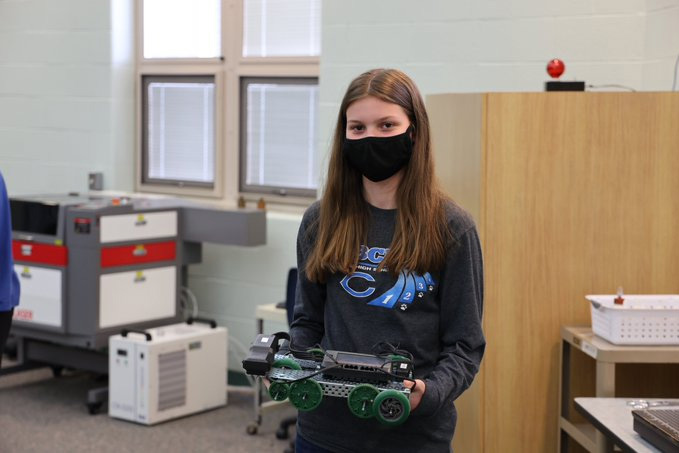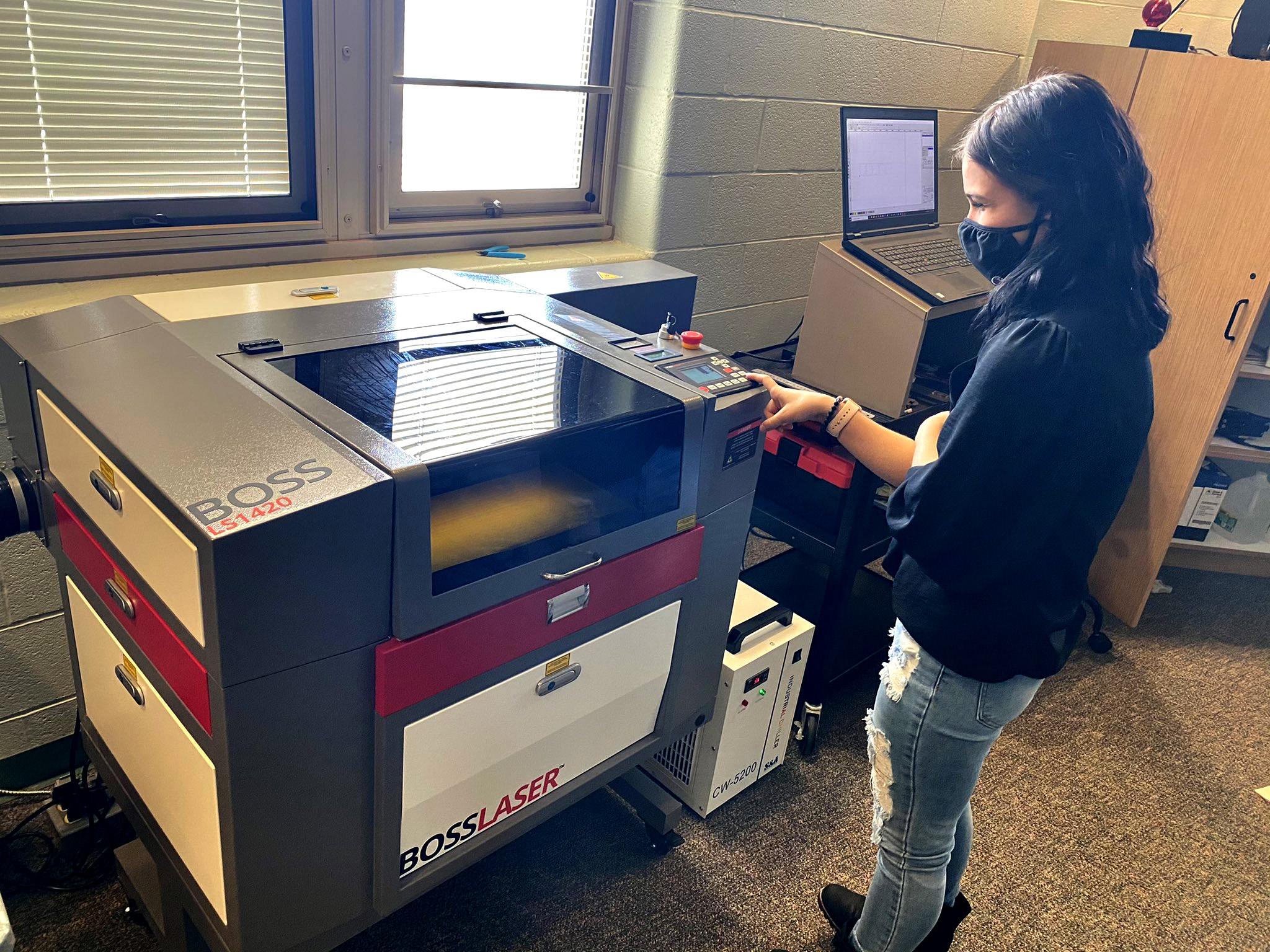A laser hums on one side of the room cutting and engraving pieces of cardboard into student-programmed, computer-generated designs. A handful of 3-D printers whir on the other side of the room turning spools of plastic wire into toy cars, rocket components and other items.
Groups of students sit around desks and build programmable, remote-control cars and other robots. Later in the day, the teacher and students in another class head outside to pilot drones around the campus.
It is the STEM program at Cambridge High School where students thrive while learning to use the latest technology in a hands-on STEM lab.

“It is amazing how fast these kids pick this stuff up,” said STEM teacher Tom Hannon. “Of course, they grew up with technology and are not afraid of it, but the speed in which they pick up the software is astonishing to me.”
Of course, it helps when students have a dynamic teacher who is just as passionate about learning.
“I think the STEM classes will continue to become more popular,” High School Principal Jason Bunting said. “Not only is the content of the classes interesting – I mean, who wouldn’t want to come to class and fly drones? – but the person teaching does a great job teaching. Mr. Hannon is outstanding at relating to the students. They want to be in there because of him.”
Robotics Class
A day in the STEM Lab starts with a robotics class. Students enter the lab, pull out their projects and tools and begin working.
Hannon, as he does in all the STEM classes he teaches, makes assignments, facilitates the work being done, provides guidance and answers questions, but does almost no lecturing. Students are assessed based on the project they complete.
For example, students recently learned about gear ratio and are designing and building cars utilizing what they learned about gears. A little competition is also involved as students will race the cars they construct to see which car can go fastest.
The cars will have a motor and a “brain” that can be programmed and communicates instructions from a controller – like a remote-controlled toy car.

“This is the culmination of what we have been learning all year,” Hannon explained. “We learned about the brain and how to program it. We learned about the motors and the gears. Now, we just give them a project and they get to figure out how to use what they learned.
“Up until now, everything we’ve been working on was set in stone,” Hannon continued. “Build this according to the instructions so you learn. Now, we give them a project and they have to figure out how to build it on their own without a set of instructions.”
According to Hannon, the remainder of the year will be project oriented. After the drag car, the student will build a vehicle that climbs.
When asked if this is the type of skills that could lead to jobs working on self-driving cars that are being tested in some metropolitan areas, Hannon laughed and said his students have already done that, just not with full-sized vehicles.
“We’ve already written programs for self-driving cars,” Hannon explained. “We have these kits with cameras and sensors that have to be programmed. Our students programmed vehicles to find a ball and go pick it up. They program them to drive around the room and use the sensors to sense the walls and not run into them.”
In fact, the skills that the students are learning apply in many industries.
“The coding part applies to all kinds of things, there are lots of robots that are being used in production,” Hannon said. “Every industry is going to robotics. Any field you go into that has anything to do with technology is using robots.”
This year, there are 20 students enrolled in robotics classes. The first semester was Intro to Robotics with the second semester being Advanced Robotics.
The High School also has a robotics club that, during non-health pandemic school years, would compete in competitions. Each year, there is a different game. Teams from schools build robots to compete in that particular game.
“You have to design and program a robot that can do what is needed in the game,” Hannon said. “It is a crossover with engineering to be able to put the parts together.”
So, it’s a good thing Cambridge also offers an engineering class as part of the STEM program. In fact, there are three engineering classes with about 50 students enrolled.
Engineering Class
The engineering class uses curriculum called Project Lead the Way which provides guidance on how to design and produce items.
“Project Lead the Way provides a great framework for our class but leaves a lot of room for expansion and deviation,” Hannon said. “My goal is to get students interested in the process.”
That process is taking an idea from concept to reality.
“It’s the process of design,” Hannon said. “You can have an idea in your head and a week later you can be holding it in your hand and test it.”
That process starts with the OnShape programming software. Onshape is a professional-grade, cloud-based CAD platform that students and educators can access on any device, anywhere, anytime.

The beauty of the OnShape software is that it can be used to design for both the 3-D printing devices and the laser in the STEM Lab.
Again, students start by completing pre-set projects. For example, the first projects on the laser were 50-millimeter boxes. Students learned to use different commands in the software to design and prepare the box for the laser.
Subsequent assignments included larger boxes, decorative designs, and vehicle parts.
The process is similar for items being produced on the 3-D printers. Engineering students are currently working on designing and printing a car. They can use both the laser and the 3-D printer on the project.
Hannon is excited about an upcoming project -- a rocket building and launching project he has taught for several years.
Engineering students will design a rocket completely using the OnShape software. They will print a plastic nose cone on the 3-D printer and cut out the fins on the laser.
“They will make the fuselage by hand and design a motor mount,” Hannon said. “The school buys the motors, but everything else is produced in the STEM lab. They just have to make it so the motor fits in.

“They are basically designing a rocket kit, no different than the one you may go into Walmart and buy,” Hannon continued. “We are making a rocket out of parts that were not intentionally meant to be part of a rocket. In the past, students would use balsa wood or cardboard to craft the rockets. This year, they will be better than ever because of the technology we have available.”
The laser is also being utilized to engrave coffee mugs, basketballs and other items as Hannon and students learn to use it.
New Classes
This type of innovation has led the idea for a production and marketing class. While still in the developmental stages, Hannon visions students coming up with marketable ideas, producing them in the lab, and then selling them to fellow students and the community.
“There would be some marketing involved and students would have to price out the cost of materials and determine what to sell the item for so they can make a little profit,” Hannon said. “It is another opportunity to provide real-world experience in the classroom.”
Computer Science Classes
Cambridge High School also will offer additional computer science classes next school year.
This school year, math teacher Karen Theodosopoulos is teaching Intro to Computer Science, an Amazon Future Engineers course designed for students who are planning to go into a technology related field.
Students learn the basics of computer programming within the Python Programming Language and the basics of computer science. The curriculum emphases computational thinking and helps develop the ability to solve complex problems using technology and computers.
Next school year, students will be able to move into the Advanced Placement Computer Science course where they will focus on writing computer software using the Java programming language.
Through the Amazon Future Engineer program, students are eligible to apply for a $10,000 college scholarship and a paid internship at Amazon after their first year of college.
Theodosopoulos also teaches a MS Apps/Google Suites class this year where students learn to use Microsoft Office and Good Suite software by completing a variety of hands-on projects.
Drone Pilot Class
Another course that sounds like fun but also offers experience is the drone class that Hannon is teaching this school year. Students learn to maneuver small drones by flying a daily mission (when the weather permits).
The students, along with Hannon, are now in the process of preparing for a drone pilot certification test. Once they earn their certifications, students will be able to pursue jobs where they actually fly drones.
STEM Emphasis
“There has obviously been an emphasis put on science and mathematics in this country and we believe the integration of those competences into a STEM program is a great way for students to learn applicable skills,” Superintendent Dan Coffman said. “Plus, the STEM classes are phenomenal, and the students seem to thrive in a hands-on, project-oriented environment.”
That is why there is already a STEM program in place at the Middle School. Hannon’s wife Angie Hannon is teaching two STEM classes at the Middle School. Using the Project Lead the Way curriculum, Mrs. Hannon is teaching an Automation and Robotics class and a Design and Modeling class. Middle School students also have access to 3-D printers and robots for those classes.
Cambridge Schools is planning to extend the STEM program to the Intermediate School next year and is in the process of hiring another STEM teacher for that building.